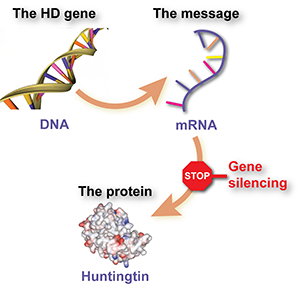
This new therapy for injecting into the spinal cord an RNA that blocks the gene responsible for the disease, has just prevented the occurrence of amyotrophic lateral sclerosis (ALS) in an animal model of the disease carrier of the responsible mutated gene. In addition, this treatment candidate blocked the progression of ALS in animals that had already developed symptoms of the disease. Very promising results, delivered by a team from the University of California San Diego, in the journal Nature Medicine.
Amyotrophic lateral sclerosis (ALS) is a neurodegenerative disease that affects nerve cells in the brain and spinal cord: the motor neurons responsible for movement communication are specifically affected, with a progressive loss of muscle control affecting the ability to speak, eat, move and breathe. While there are symptomatic treatments for ALS, there is currently no cure. The majority of patients succumb to the disease 2 to 5 years after diagnosis. There are 2 types of ALS:
sporadic: this is the most common form, accounting for 90 to 95% of cases;
family, 5 to 10% of cases.
Previous research has shown that at least 200 mutations in the SOD1 gene are linked to the development of ALS.

The prospect of an effective therapy, “the most powerful ever validated on an animal model”
A responsibility gene, the SOD1 gene: the function of this gene is to provide instructions for the manufacture of the enzyme superoxide dismutase, which breaks down superoxide radicals, free radicals derived from oxygen, byproducts of processes normal cellular. Previous research has suggested that mutations in the SOD1 gene can lead to ineffective removal of these superoxide radicals or create other toxicities that cause the death of motor neurons, resulting in the development of ALS.
Silencing the guilty gene: the new approach is to inject an artificial RNA molecule capable of silencing or disabling the responsible gene. This molecule is delivered to cells via a harmless adeno-associated virus. Here, injections in 2 sites of the spinal cord of adult mice expressing a mutation of SOD1 causing ALS, either just before the onset of the disease, or at the onset of the first symptoms, allow almost complete protection. complete motor neurons, junctions between neurons and muscle fibers. In adult mice already showing ALS-like symptoms, the injection blocked the progression of the disease and the degeneration of the motor neurons. No negative side effects were seen in mice.
This is the prospect of an effective therapy, “the most powerful ever validated in murine models of ALS linked to the mutated SOD1 gene”, concludes the main author, Dr. Martin Marsala, professor in the Department of Anesthesiology of the UC San Diego School of Medicine. This new mode of delivery of gene silencing therapy may be effective in treating other inherited forms of ALS or other spinal neurodegenerative disorders that require gene therapy by spinal administration.
Finally, the team also tested the injection approach in adult pigs, whose dimensions of the spinal cord are similar to those of humans, to validate the safety and efficacy of the treatment.
Researchers confirm that the procedure can be performed reliably and without surgical complications. The next steps should validate safety and specify the optimal dosage for humans.
